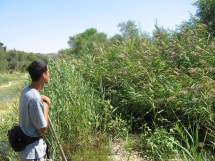Common reed, Phragmites australis (Cav.), is among the most widespread angiosperms in the world and is found on every continent except Antarctica. Phragmites grows in all aquatic and brackish environments and spreads through both asexual and sexual structures. Rapid expansion of populations in wetlands along the East Coast was previously thought to be driven by human disturbance, but evidence now suggests that a cryptic invasion of an European genotype has occurred in the eastern United States (and some western locations), and this biotype continues to spread across the continent.
Phragmites is represented by three distinct lineages in North America – native P. australis subsp. americanus, which has several dozen distinct haplotypes, an invasive European haplotype, and P.australis subsp. berlanderi, which is of unknown origin. In the southwestern US, we have detected new invasive populations, as well as hybridization between the native and European lineages. Our lab studies the causes and consequences of invasive lineage establishment and hybridization in this arid region.



